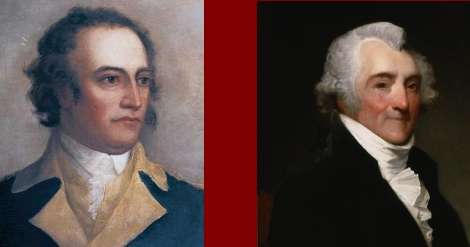Margaret Brown of County Cork in Ireland had a fierce beauty and a temper to match. She crossed from Ireland in 1723 with her future husband, the tall and wiry Owen O’Sullivan. Together they would have two sons who helped shape the future of their adopted country.
Just how Owen and Margaret came to America is pieced together from several family histories. Owen was heir to his family estate and castle in Ardea in County Kerry on Ireland’s southeast coast. By 1723, however, the castle was in ruins. The O’Sullivans had sided with King James II in his effort to regain the British throne.
When King William of Orange dispatched James to France in the Battle of the Boyne in 1692, any chance of Owen O’Sullivan regaining his ancestral power went with him. Owen was raised and schooled in France.
Owen’s own father died in France, as Owen recalled: “My father died, as they told me, of an ulcer raised in his breast, occasioned by a wound he received in France, where he fought a duel with a French officer; and when he wounded his antagonist, another runned a sword through his back so that the point appeared at his breast.”
Owen O’Sullivan
Upon returning to Ireland after his schooling, Owen O’Sullivan fell in love. But his intended wife was not acceptable to his mother, who refused to consent to the marriage. Owen threatened that if she did not relent, she would never see him again.
With few prospects in Ireland, the 31-year-old Owen set off from Limerick to America. A well-educated Catholic, he arrived and settled in Newburyport, Massachusetts where he was indentured to a Newbury farmer to pay for his voyage.
But Owen had higher expectations. He wrote a letter to the Rev. Samuel Moody of York, Maine. He penned the letter in multiple languages, demonstrating his fluency in Greek and Latin, and expressing his hopes for a better position.
Moody, recognizing Owen’s talents, loaned him money to set himself up as a teacher in Berwick, Maine. For nearly 50 years, he taught in Berwick and Somersworth, N.H.
Margaret Brown
Margaret Brown came from less regal beginnings. Born in County Cork, both her parents died when she was just an infant. Margaret was tenacious. It’s unclear how she got on the same boat as Owen from Ireland to America. She may have pledged her labor to pay for passage, or she may have been a stowaway. Margaret was only nine years old when she crossed to America (Owen was 31).
About ten years later, Owen and Margaret would marry and they dropped the O from their name. Margaret, known as Margery, was a small woman, and one history describes her: “She was very remarkable for her beauty, her vanity, her talents and her energy; and not less remarkable for the violence of her temper.”
Margaret had none of Owen’s sophistication or education, but she had the drive to manage the family farm in Berwick and she imbued her children with ambition while Owen kept school.
The union of the mild, bookish school teacher and the fiery, beautiful stowaway would hit a major pothole in 1743. Overwhelmed by his wife’s demeanor, Owen left his family.
An Abject Apology to Owen O’Sullivan
To try to make up with him, Margaret published an advertisement in the Boston Post:
My dear and loving Husband, Your abrupt departure from me, and forsaking of your wife and tender babes, which I now humbly acknowledge and confess I was greatly, if not wholly the occasion of, by my too rash and unadvised speech and behavior towards you ; for which I now in this public manner humbly ask your forgiveness; and hereby promise upon your return to amend and reform, and by my future loving and obedient carriage towards you, endeavor to make an atonement for my past evil deeds, and manifest to you and the whole world that I am become a new woman, and will prove to you a loving, dutiful and tender wife.
Owen, for his part, never got over his first love in Ireland. Even at an advanced age, the memory of the girl he left behind in Ireland could bring him to tears. True to his word, he never communicated with his mother again.
By the time of their separation, Margaret and Owen O’Sullivan already had two children. They would reunite and eventually have four sons and a daughter. They lived together another 50 years until Owen died at age 104.
Two Governors
Two sons played prominent roles in the American Revolution. John Sullivan apparently took after his mother. A fierce soldier, short and stout, he became a general in the Continental Army and governor of New Hampshire.
James Sullivan, meanwhile, would rely on legal skills to win him fame. James suffered from epilepsy and a bad leg that was injured while working on the family farm as a boy. Nevertheless, he would become a key supporter of John Hancock and Samuel Adams. After the Revolution he was one of Massachusetts’ leading lawyers and was elected governor twice.
Thanks to: The Story of Berwick, The Life of James Sullivan and New Hampshire, An Epitome of Popular Government. This story last updated in 2022.

5 comments
Great story, love all the bits of history that you post!
[…] couple's stormy marriage created five sons and a daughter — among them were two governors of three […]
[…] with Washington at his headquarters in Cambridge. Washington kept his distance and asked Gen. John Sullivan to interview Rogers in Medford. Sullivan interviewed the guerilla fighter twice and advised […]
[…] from near and far covered the sensational trial. Massachusetts Attorney General John Sullivan, Revolutionary War hero and later governor, led the prosecution. Harrison Gray Otis and John […]
[…] of the Revolutionary elite, including George Washington, Marquis de Lafayette, Comte de Rochambeau, John Sullivan and Nathanael […]
Comments are closed.